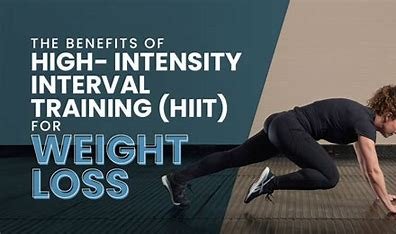High-Intensity Interval Training (HIIT) is one of the most effective and efficient ways to burn fat, improve cardiovascular health, and build muscle endurance. It’s a form of exercise that alternates between short bursts of intense activity and periods of lower-intensity recovery or rest. When it comes to fat loss, HIIT can deliver exceptional results because of its ability to burn calories during and after the workout.

Why HIIT is Effective for Fat Loss
- Increased Calorie Burn (During and After Workout)
- HIIT keeps your heart rate elevated, which increases the calorie burn both during the workout and in the post-exercise period (the afterburn effect, or EPOC — Excess Post-Exercise Oxygen Consumption). After a HIIT session, your body continues to burn calories at an elevated rate for several hours, even while you’re at rest.
- Time Efficiency
- One of the main benefits of HIIT is that you can achieve the same or even better results in a shorter time compared to traditional steady-state cardio (like jogging). HIIT workouts typically last anywhere from 15 to 30 minutes, making them a great option for those with busy schedules.
- Fat-Burning Without Muscle Loss
- Unlike steady-state cardio, which can sometimes result in muscle loss, HIIT can help you burn fat while preserving muscle mass. The high-intensity bursts promote muscle-building processes, while the recovery periods allow muscles to reset.
- Improved Insulin Sensitivity
- Regular HIIT has been shown to improve insulin sensitivity, which helps your body use glucose more effectively and reduces the likelihood of storing excess fat, particularly around the belly.
- Variety and Flexibility
- HIIT can incorporate a variety of exercises, making it easier to stick with a program over time. You can use bodyweight exercises (like squats and push-ups), cardio (sprinting or cycling), or even strength movements (kettlebell swings or dumbbell exercises). This flexibility keeps workouts interesting and engaging.
How HIIT Works for Fat Loss
- Intensity: During the “high-intensity” part of a HIIT workout, you’re pushing yourself to work at about 80-95% of your maximum effort. This level of intensity forces your body to use more energy, which contributes to fat loss.
- Intervals: The “low-intensity” periods allow your heart rate to come down slightly and give you a brief rest. This period might involve walking, light jogging, or complete rest, depending on the workout structure.
- Afterburn Effect (EPOC): After a HIIT session, your body remains in an elevated calorie-burning state for hours. This happens because your body needs more oxygen to restore balance and recover from the intensity of the workout. The result is that you continue to burn calories at an elevated rate even after you’ve finished exercising.
HIIT for Fat Loss: Sample Workouts
Here are a couple of simple and effective HIIT workouts you can try, depending on your fitness level.
1. Beginner HIIT Workout
- Warm-Up: 5 minutes of light cardio (jogging, cycling, or dynamic stretches).
- HIIT Workout (20 minutes):
- 30 seconds of jumping jacks
- 30 seconds of rest
- 30 seconds of bodyweight squats
- 30 seconds of rest
- 30 seconds of mountain climbers
- 30 seconds of rest
- 30 seconds of high knees
- 30 seconds of rest
- Cool-Down: 5 minutes of stretching or slow walking.
2. Intermediate HIIT Workout
- Warm-Up: 5 minutes of light cardio and dynamic stretches.
- HIIT Workout (30 minutes):
- 45 seconds of burpees
- 15 seconds of rest
- 45 seconds of jump squats
- 15 seconds of rest
- 45 seconds of push-ups
- 15 seconds of rest
- 45 seconds of jumping lunges
- 15 seconds of rest
- Cool-Down: 5-10 minutes of stretching.
3. Advanced HIIT Workout
- Warm-Up: 5 minutes of dynamic stretches and light cardio.
- HIIT Workout (30 minutes):
- 30 seconds of sprints (on treadmill or outdoors)
- 30 seconds of rest
- 30 seconds of burpees
- 30 seconds of rest
- 30 seconds of kettlebell swings
- 30 seconds of rest
- 30 seconds of box jumps
- 30 seconds of rest
- Cool-Down: 5 minutes of stretching and slow walking.
Tips for HIIT Fat Loss Success
- Focus on Intensity: The effectiveness of HIIT lies in the intensity of your efforts during the work periods. Make sure you’re pushing yourself hard enough to elevate your heart rate and challenge your limits.
- Start Slow: If you’re new to HIIT, begin with shorter intervals and longer rest periods. As you get stronger and more accustomed to the workouts, you can increase the intensity or reduce the rest periods.
- Stay Consistent: To see fat loss results, aim for at least 2-3 HIIT sessions per week, along with a balanced diet. Overdoing HIIT may lead to fatigue or burnout, so listen to your body and allow time for recovery.
- Pair with Strength Training: Combining HIIT with strength training can accelerate fat loss while preserving and building muscle mass. Strength exercises can also help improve your HIIT performance over time.
- Nutrition Matters: To lose fat, you must maintain a caloric deficit (burning more calories than you consume). Pair your HIIT workouts with a healthy, balanced diet that supports fat loss.
- Rest and Recovery: Don’t neglect recovery—HIIT is intense, so make sure to rest between sessions and prioritize sleep. Your body needs time to repair and rebuild muscle tissue.
Summary: Why HIIT Works for Fat Loss
- Efficient and Time-Saving: HIIT workouts can be done in less time than traditional cardio.
- Boosts Metabolism: The afterburn effect keeps you burning calories for hours after your workout.
- Preserves Muscle Mass: HIIT helps burn fat while maintaining lean muscle.
- Burns More Fat: HIIT is particularly effective at reducing visceral fat (the fat stored around your organs).
